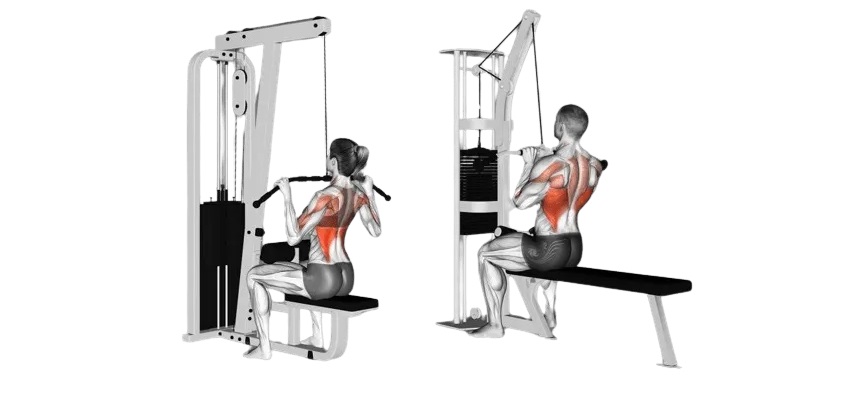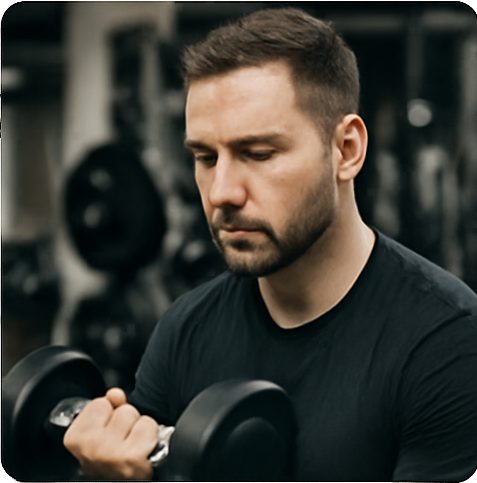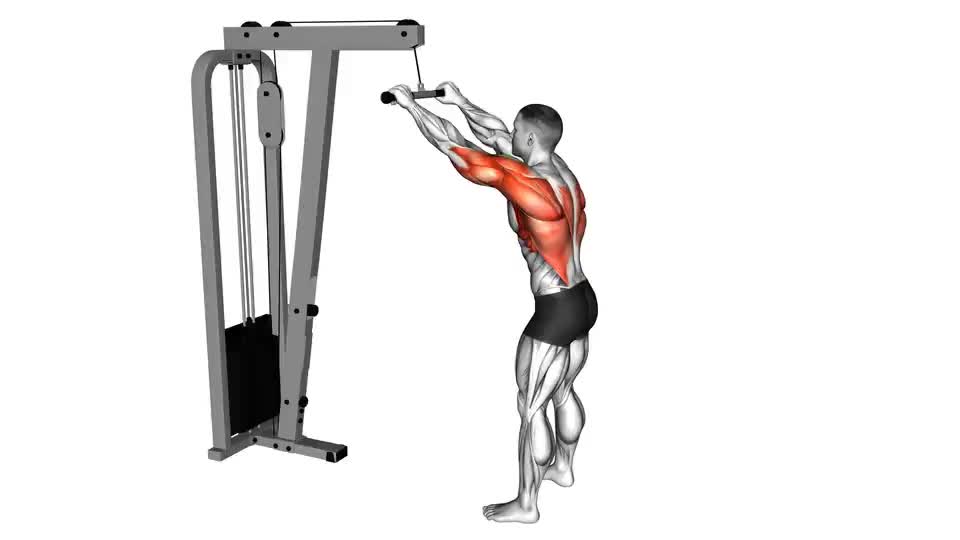When I first looked up lat pulldown muscles worked, I assumed it was just a back thing—like, obviously it’s for your lats, right?
Well… not the way I was doing it.
Back then, every rep felt like an arm workout. My biceps were screaming, but my back? Barely anything. I figured maybe that was normal, until I stumbled on a few Reddit threads where people were saying the exact same thing—“Why can’t I feel my lats?”
That’s when it clicked: I wasn’t actually using the right form. I was just pulling the bar down with my arms and hoping for the best.
So I started digging. I watched videos, read advice, even filmed myself. And eventually, I figured out why this move wasn’t working for my back—and how to fix it.
Lat Pulldown Muscles Worked The Real Ones
When I finally looked into what lat pulldown muscles worked, I realized it wasn’t just lats. Like, not even close.
Yeah, your latissimus dorsi is the star here. That’s the big wing-like muscle running down your back. But depending on your grip, angle, and form, you’re also tagging a bunch of other spots.
At first, I mostly felt it in my biceps and forearms—which told me I was doing it wrong. My rear delts and traps got a bit of love too, but not my lats. Not until I fixed my posture and slowed things down.
Eventually, I learned that lat pulldowns aren’t just about pulling the bar down. It’s about controlling the whole movement and knowing which muscles should actually be doing the work.
Here’s how it usually breaks down 👇
Muscles Worked by Grip Type
| Grip Type | Primary Muscles | Secondary Muscles |
|---|---|---|
| Close-grip (neutral/V-bar) | Lats (lower/mid), Biceps | Traps, Rhomboids, Forearms |
| Wide-grip (overhand) | Lats (outer), Upper Back | Rear Delts, Teres Major, Biceps |
| Underhand (supinated) | Lats, Biceps (more emphasis) | Posterior Delts, Forearms, Lower Traps |
| Straight-arm pulldown | Lats (isolation) | Triceps, Core (stabilizing) |
Also worth noting: if you’re rocking bad form (like I was), you might feel this move more in your arms, shoulders, or even your neck. That’s not ideal.
Fixing your form = letting the lats actually do their job. The name says “lat pulldown,” but it takes a full team of muscles to pull it off right.
Why I Couldn’t Feel My Lats And How I Fixed It
At first, I was cranking out lat pulldowns all the time—but weirdly, I wasn’t actually feeling them in my lats. Mostly just my arms doing all the work. Sound familiar?
Turns out, it wasn’t the machine. It was me. Mostly my form, and partly some stuff I didn’t even know I was doing wrong until way later.
But before I break down what went sideways, let’s talk about how to actually do a standard lat pulldown the right way.
Basic Lat Pulldown Steps (Neutral or Overhand Grip)

This is what finally got me feeling it in the right places:
- Sit down with your knees under the pads. Don’t skip that part—it keeps you locked in.
- Grab the bar just wider than shoulder-width (or close-grip V-bar, if that’s your thing).
- Lean back slightly—just a little. Keep your chest up.
- Now here’s the big one: pull your elbows down and back—not just down.
- Bring the bar to your upper chest, pause for a sec, then slowly let it go back up.
- Don’t yank. Don’t swing. Don’t use momentum. You’re not doing CrossFit.
Problem 1: I Was Just Using My Arms
I’d load the stack, pull hard, and wonder why my biceps felt smoked—but not my lats.
Why? Simple:
- I was going too heavy way too soon.
- I was pulling with my hands, not my elbows.
- I leaned back too much and basically turned it into a row.
What helped:
- Lighter weight (yep, even if it hurts your ego).
- Focusing on the cue: “pull with your elbows, not your hands.”
- Slowing the reps down—especially on the way up.
- Filming myself. Eventually, I filmed myself (yep, looked goofy as hell), but it straight-up showed me everything I was messing up.
Problem 2: My Lats Were Uneven—and I Didn’t Know Why
One side would light up. The other? Felt like it skipped gym day.
Eventually, I figured out I have mild scoliosis. Nothing serious, but enough to throw off muscle activation.
Here’s what helped even things out:
- Single-arm lat pulldowns – gave me better mind-muscle connection.
- Slower tempo – I could actually feel both sides working.
- Filming my form again – I wasn’t symmetrical at all.
Now I make a point to train both sides evenly, and I’ve started seeing way better results.
Quick Tip Recap
- Pull with elbows, not hands.
- Use less weight and more control.
- Try single-arm work if one side isn’t firing.
- Don’t be afraid to film your reps—it’s awkward, but worth it.
Fixing your form is where the gains start. Trust me—I’ve been the guy who thought he was training lats, but was really just crushing arm day by accident.
Lat Pulldown vs. Other Back Exercises
At one point, I started wondering—was the lat pulldown even the best move for me?
So I messed around with other back exercises. Some gave me a better mind-muscle connection. Others didn’t hit the right spots at all.
Here’s how they stacked up for me 👇
Rows vs. Pulldowns
Rows hit my mid-back like crazy. Felt more squeeze between the shoulder blades. But I didn’t get the same lat stretch that pulldowns gave me.
So for me:
- Rows = great for thickness
- Pulldowns = better for that wide V-taper look
Pull-Ups vs. Pulldowns
Meanwhile, pull-ups totally hit different—felt like my whole upper body was straight-up firing on all cylinders. But I couldn’t control the movement as much, especially early on.
Pulldowns helped me slow things down and actually learn what my lats felt like when they were working.
Now I use both, but I always recommend learning on pulldowns first.
Resistance Bands (Surprisingly Helpful)
I know, I know—bands don’t look that cool. But man, they’re actually solid for learning how to activate your lats.
I used them on rest days just to drill the elbow path. No weight. Just reps.
Helped me fix my mind-muscle connection big time.
What Hits What
| Exercise | Lats | Mid Back | Biceps | Mind-Muscle Feel |
|---|---|---|---|---|
| Lat Pulldown | ✅✅✅ | ✅ | ✅✅ | ✅✅✅ |
| Barbell/Dumbbell Rows | ✅✅ | ✅✅✅ | ✅ | ✅✅ |
| Pull-Ups | ✅✅✅ | ✅ | ✅✅ | ✅✅ |
| Resistance Bands | ✅✅ | ➖ | ➖ | ✅✅✅ |
| Machine Rows | ✅ | ✅✅✅ | ✅ | ✅ |
Note: ✅✅✅ = strong activation; ✅ = noticeable; ➖ = minimal
Bottom line? Each move has its place. But if you’re trying to figure out the lat pulldown muscles worked, know this:
Pulldowns are your go-to for lat isolation—especially if you’re still building that mind-muscle link. The rest? They’re great add-ons, but nothing beats good form and control on pulldowns when you’re just starting out.
These days, I always start back day with lat pulldowns. Not crazy weight—just enough to wake my lats up. I treat it like a primer. Then I hit rows, or sometimes I’ll superset with curls for that arm+back pump. Slower reps (10–15 range) made a huge difference for me.
And hey, if you’re still not feeling your lats during pulldowns? Don’t even stress. I’ve 100% been there.
Just dial back the weight, fix the form, and give it some time. You’ll get that lat squeeze soon enough.
Start lighter. Nail the form. Think “elbows down and back.” And yeah, filming yourself might feel cringe—but it’s probably the one thing that helped me most.
You’ll get there. Just keep pulling.

Hi, I’m the editor here at Leadman Fitness. We’re a manufacturer focused on producing top-quality barbells, plates, kettlebells, dumbbells, and strength training gear. I’ve been into sports and fitness for years, and I know my way around all kinds of gym equipment—both from using it and helping create it.
I spend a lot of time understanding the real problems people run into in the gym—whether it’s beginners trying to pick the right gear or experienced lifters looking for something more durable. I stay in close touch with our production team and talk directly with other equipment makers, so we’re always improving based on what real lifters and coaches are looking for.
What I share comes from hands-on experience—stuff that actually helps people train better, not just in theory, but in real gyms.
